
 Kinect
Kinect
Microsoft's Kinect is already one of the best examples of modern technology in the way it can interpret the world around it. Now, it's going to change people's lives
Even version one of Kinect surprised us with it's capabilities, but now, it's going to make a real difference to a particular group of people.
If you're deaf, it's bad enough that you miss out on the intricate world of sound, but it's probably even worse - if it even makes sense to compare these things - that you can't communicate the same way as hearing people.
Sign language is a wonderful and rich medium for deaf people to communicate with other "speakers" but the number of people in the world who can sign is probably a small fraction of a percent. And between signers, there are many different sign languages in the world, not mutually intelligible.
In an ideal world, deaf people would be able to sign and hearing people would be able to understand, without having to learn the gestural language. And wouldn't it be great if hearing people could talk, and deaf people could somehow "hear" them?
Utopian
This utopian idea remains some way off but it's a lot closer thanks to work being done by Microsoft's research arm .
They've taken the new Kinnect and figured out a way for it to "read" sign language. Ultimately, it will mean that a deaf person can "sign" into a camera, and the system will recognise the gestures and "speak" the meaning of them in a natural-sounding human voice.
It works the other way around, too. The system can "listen" to spoken speech, and then, with an avatar, show the sign language equivalent. It's true, two-way communication.
It can even translate between different sign languages, and between different spoken languages.
As we said, this is in its early stages, but the concept has been well and truly proved.
Video after the break.
Video
Tags: Technology


Comments